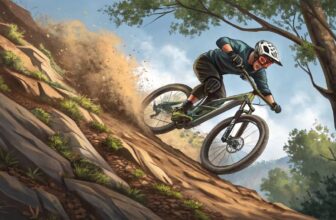Understanding Cranksets
Getting hip to cranksets is a must for mountain bikers who wanna get the most out of their rides. Here, we’ll chat about chainring setups and crank lengths—critical stuff for gearing up right for all sorts of biking scenarios.
Chainring Configurations
Let’s talk chainring setups—they’re like the heartbeat of a crankset. Most bikes come decked out with one, two, or sometimes three chainrings. Nowadays, mountain bikes lean toward single-ring (1x) setups thanks to their no-nonsense vibe and trustworthiness when things get bumpy.
With just one chainring, you dodge the headache of chain slips and trim some weight, sweet for those hitting the trails or diving into adventure sports.
If you’re the type who craves the freedom to roam, double (2x) or triple (3x) chainring setups spread out your gear choices. Handy for commuters, or for those just looking for a gear boost, these setups offer range but come with a heads up: tinkering with chainring sizes isn’t a walk in the park due to their bespoke design, and mismatch can lead to dodgy shifting and chain bailouts.
| Chainring Configuration | Works Best For | Benefits |
|---|---|---|
| 1x (Single) | Trail blazers, adventure thrill seekers, mountain racers | Less complicated, lighter, fewer chain hiccups |
| 2x (Double) | All-terrain travelers | More gearing options |
| 3x (Triple) | Big haul carriers, hill conquerors | Max gear spread |
Got the itch for gear ratios? Check out our deep dive on mtb gear ratios.
Crank Length Variations
Crank length—ever thought about it? It messes with how comfy and efficient your ride is. Crank lengths vary from 165mm to 175mm in little 2.5mm jumps. Your pick depends on leg length, how you like to pedal, and dodging pedal strikes on the trails.
Most mountain bikes play it cool with 170mm or 175mm cranks. Longer cranks mean more oomph, perfect for those cranking up hills. But shorter cranks let you spin faster and pedal more smoothly—trade some ground clearance for that capability, though, which isn’t always ideal on rocky terrain.
| Crank Length | Use Case | Advantages |
|---|---|---|
| 165mm | Short-statured, rapid twirlers | Better for spinning, fewer pedal whacks |
| 170mm | General mountain biking | A good middle ground for power and space |
| 175mm | Lofty folks, hill climbers | More force, better climb power |
To dial in your comfort and riding finesse, match your crank length to both your ride’s vibe and your body’s build. For more wise words, peek at our mountain bike sizing guide.
When all’s said and done, wrapping your head around chainring varieties and crank length numbers up your game in both bike performance and comfort. Picking the right crankset lets you roll through any rough patches with ease. Want more know-how on keeping your bike shipshape? Explore our mountain bike maintenance and mountain biking essentials guides.
Modern Crankset Features
Cranksets today have spun into a realm that suits all sorts of rider whims. We’re going to talk about direct-mount cranksets and gravel bike setups, and why they make biking a whole lot better.
Direct-Mount Cranksets
Mountain bikers are pretty sweet on direct-mount cranksets because they’re straightforward and get the job done efficiently. Instead of the whole spider web of parts, this setup mounts the chainring directly to the crank arm— like one fell swoop miracle. What does that mean for you? A few cool perks:
- Shave Off Weight: Ditching the spider means your bike weighs less, which can be a literal weight off your shoulders, especially if you’re into racing or just flaunting your speed on the trails.
- Get Stiff: The direct link amps up stiffness, boosting power transfer and making each pedal stroke count.
- Simplified Wrenching: Swapping chainrings is a breeze. Less fuss, more riding. Change things up on the fly without reaching for a toolbox.
| Feature | Traditional Crankset | Direct-Mount Crankset |
|---|---|---|
| Weight | Heavier | Lighter |
| Stiffness | Lower | Higher |
| Maintenance | Complex | Simple |
| Chainring Mounting | Spider | Direct |
For a full scoop on upgrades, swing by our guide on mtb drivetrain compatibility.
Gravel Bike Setups
Gravel bikes don’t care where you go—paved streets or wild trails, they’re up for it. Their cranksets are designed to keep pace with the action, making them a versatile choice.
- 1x Drivetrains: Gravel bikes often rock a single front chainring with a wide-ranging rear cassette. Keeps things easy and helps avoid those unwanted chain drops, especially when things get bumpy.
- Chain Guides: Remember when chain guides were only for the adrenaline seekers on downhill bikes? Times have changed. They’ve slimmed down and found their place in the gravel scene. These little gadgets help keep your chain where it should be, even when the ride gets gnarly.
- Crank Lengths: Shorter crank arms are common here, providing more clearance when you’re dodging rocks and roots.
| Feature | Road Bike | Gravel Bike |
|---|---|---|
| Drivetrain | 2x / 3x | 1x |
| Chain Guides | Not common | Common |
| Crank Length | Longer | Shorter |
Want to get even savvier on your bike setup? Check out more about mtb gear ratios and mountain bike maintenance.
Understanding what makes direct-mount cranksets and gravel bike setups tick lets riders tailor their rides. From racers to casual commuters, there’s something to enhance how you roll through life.
Exploring Drivetrain Components
Mountain bike lovers, if you’re keen on making your ride smoother and more fun, it’s time to delve into the nitty-gritty of drivetrain parts. Let’s break down derailleurs, shifters, chainrings, and cassettes in a way that’s understandable and practical.
Derailleurs and Shifters
A mountain bike’s drivetrain wouldn’t be complete without these handy bits—derailleurs and shifters. Think of derailleurs as your bike’s built-in chain controller, flipping the chain between gears at the behest of shifters.
Derailleur Types:
- Front Derailleur: Takes the chain on a tour through the chainrings.
- Rear Derailleur: Jumps the chain over the cassette sprockets.
Shifters come in several flavors, including trigger, twist, and electronic. Each acts like a remote control for your derailleurs.
| Component | What It Does |
|---|---|
| Front Derailleur | Switches chain among the chainrings |
| Rear Derailleur | Guides chain along cassette sprockets |
| Shifters | Gear-switching maestros |
Mountain bikers often go for derailleurs with a clutch mechanism in the back. This cool feature grabs onto the chain, stopping any rogue clanging against the chainstay. If you’d like to geek out over gear ratios, check out our MTB gear ratios guide.
Chainring and Cassette Options
Chainrings and cassettes? They’re the behind-the-scenes crew that sets your gears’ rhythm and smooths out your ride. Getting them right personalizes your bike to your adventure style.
Chainrings:
Chainrings come in different sizes defined by how many teeth they’ve got. Mountain bikes usually opt for the 1x drivetrain—one chainring only—compared to the double-ringers on road bikes.
Why Go 1x?:
- Save weight and ditch extra parts
- No front derailleur or extra shifter cable needed
| Chainring Type | Teeth Count | Common Ride |
|---|---|---|
| Single (1x) | 30 – 36 | Mountain Biking |
| Double (2x) | 28 – 50 | Road, Gravel Riding |
1x setups often show off ‘narrow-wide’ teeth alternating in width to keep your chain snug and secure.
Cassettes:
Cassettes range widely from how many sprockets they offer to the gearing options. Some hotshot mountain bikes and gravel bikes even boast 13-speed cassettes for a supercharged experience.
Cassette Faves:
- 10-50 teeth (favorite in 12-speed rigs)
- 10-51 teeth (a hit for 13-speed racers)
| Cassette Speed | Small Cog | Big Cog | Perfect For |
|---|---|---|---|
| 12-speed | 10 teeth | 50 teeth | Trail, Enduro |
| 13-speed | 10 teeth | 51 teeth | Gravel, XC Racing |
Locking in the right chainring and cassette can revolutionize how you hit the trails and the longevity of your trusty bike. If you’re wondering how to keep it in top shape, check out our tips on mtb drivetrain compatibility.
Having a good handle on your derailleurs, shifters, chainrings, and cassettes means you’re ready to tweak your mountain bike for any sort of off-road fun. For more nuggets of bike wisdom, don’t miss our mountain bike maintenance guide.
Check Out Chain Guides
Getting the scoop on chain guides can seriously level up your mountain biking game, especially if you’re into zooming down trails or tearing up those downhill or freeride paths.
Evolution of Chain Guides
Way back when, chain guides were the go-to for downhill and freeride fanatics. Over the years, they’ve gone from bulky to sleek – now they’re real featherweights and popping up on trail and downcountry rides too, making them a staple for more bikers than ever before.
| Aspect | Then | Now |
|---|---|---|
| Bike Type | Downhill, Freeride | Trail, Downcountry, Gravel |
| Weight (grams) | Heavy | 30 – 100 |
Pros and Cons
Perks of Chain Guides
- Stays Put: A top-notch perk of the chain guide is its knack for keeping your chain on track, ditching those annoying drops.
- Extra Armor: With chain guides boasting bash guards, your chainring gets a shield against nasty rocks and debris.
- Jack of All Trades: Today’s chain guides fit in with all sorts of bikes from road to gravel that rock a 1x drivetrain, especially handy on rough rides.
Bumps in the Road with Chain Guides
- Weight Factor: Even though they’re lighter now, adding 30 to 100 grams might irk those trying to keep their setup as slim as possible.
- Fuss and Fiddle: While fiddling with a guide can mean chain rub, it could be more hassle than a laid-back rider wants to deal with.
If you’re mulling over adding a chain guide to your bike, it’s worth weighing up these factors. Need tips on keeping your ride in peak shape? Check out our write-up on mountain bike maintenance. Considering a drivetrain switch? Our mtb drivetrain compatibility guide is here to help.
Grasping the ins and outs of chain guides gives riders some serious insight, kicking their biking adventures up a notch while keeping their performance on point on the trails.
Suspension Fork Types
Getting the right suspension fork for your mountain bike is like finding the perfect pair of sneakers; it can change your ride completely. Two big players in this game are air forks and coil forks, each flaunting its own set of charms and quirks.
Air Fork Characteristics
Air forks are like the Swiss Army knife of bike suspension. They use compressed air to do the heavy lifting, making them the go-to for many bikers, from newbies to trail veterans. They’ve got some sweet perks (Cykel House):
| Feature | Benefit |
|---|---|
| Weight | Super light, perfect if you’re trying to keep your bike as featherlike as possible |
| Adjustability | You can tweak the air pressure to your heart’s content, getting that just-right feel |
| Maintenance | Needs a bit of TLC now and then to keep the air pressure and performance in check |
Air forks shine in their versatility. They’re a hit among those buying their first mountain bike and seasoned trail warriors alike. You can dial in your setup based on your weight and the kind of terrain you’re tackling — it’s like customizing your ride to hug the trail just right.
Plus, adjusting is a breeze; just pump in more air or let some out to get it as firm or bouncy as you like. For tips on keeping them in prime shape, peek at our mtb fork maintenance guide.
Coil Fork Advantages
Coil forks keep it old school with metal coil springs, and they’re all about giving you a sturdy and predictable ride.
| Feature | Benefit |
|---|---|
| Suspension Feel | Offers a smooth and stable ride, like cruising down a buttery slope |
| Durability | Built like a tank to take on rough roads and aggressive rides |
| Traction | Awesome grip and consistency on tiny bumps — perfect for tricky trails |
Though they lack the easy adjustability of their air counterparts, coil forks are often the heroes for pro riders who crave unwavering dependability. They’re top-notch at creating a cozy, smooth ride and hold steady even on the bumpiest paths. If you’re tackling technical climbs or bouncing over rocky patches, coil forks might just be your bestie. Budget-wise, they’re a solid pick too. Pair them with the right mtb upgrades to heighten your outdoor adventure.
Knowing the ins and outs of air vs. coil forks helps you pick the right match for how and where you ride. Whether you’re chasing adrenaline-fueled adventures or just want a bike that’s tough enough to handle your weekday jaunts, choosing the right fork can up your mountain biking game significantly.
Rear Suspension Shocks
Rear shocks are like the secret sauce for full-suspension mountain bikes, working together with the front forks to cook up a smooth and responsive ride. Whether you’re trying to figure out air shocks or coil shocks, picking the right rear setup can turn bumping down trails into a world of fun and comfort. In this part, let’s chat about what makes air shocks and coil shocks special.
Air Shocks Overview
Air shocks on your bike are like having a customizable cloud; they use compressed air to get the suspension bouncing just right. These bad boys are known for being lightweight and super adjustable.
Key Features:
- Adjustability: You can tweak air shocks by fiddling with air pressure to control sag and how firm the ride feels. This means you can style your bike to fit how you like to roll.
- Lightweight: Skipping the heavy metal springs, air shocks keep things light, helping you shave off some bike weight.
- Versatility: Air shocks adapt like a chameleon to different terrains, popular with both laid-back and high-intensity riders.
| Feature | Air Shocks |
|---|---|
| Weight | Light as a feather |
| Adjustability | Sky-high |
| Suspension Medium | Air, baby! |
| Customization | Tweak with Air Pressure |
If you’re curious about getting your air shocks tuned right, check out our guide on MTB suspension setup.
Coil Shocks Explained
Coil shocks are like the reliable old friend who never lets you down. Running on metal springs, they provide a smooth and steady suspension ride that feels more predictable than air shocks. They’re the go-to for folks who hit the trails hard and rough.
Key Features:
- Durability: Built like a tank, coil shocks handle tough biking conditions and just keep going.
- Plush Ride: They give a cushiony feel, especially on gnarly, uneven trails, improving grip and stability.
- Steady Performance: The metal springs ensure a predictable ride across bumps and dips.
| Feature | Coil Shocks |
|---|---|
| Weight | Built like a tank |
| Adjustability | A bit limited |
| Suspension Medium | Metal springs |
| Customization | Preload Tweaks |
Coil shocks aren’t totally rigid though; you can play around with settings like preload, and compression to fine-tune them. Care to peek at maintaining your rear shocks? Swing by our MTB rear shock guide.
Choosing between air and coil shocks boils down to how you ride and what terrain you’re playing on. Want to dig deeper into how bikes tick? Check our MTB drivetrain compatibility guide.
Chain Technology Insights
Got a bike? Fancy the thrill of mountain biking? Well, understanding your bike’s chain tech is gonna be your best friend. Knowing how it ticks to make sure it all fits right, this info’s the gear you need!
Bicycle Chain Basics
Now, the bicycle chain, yep, it’s your drivetrain’s superhero, getting all that pedal power over to your back wheel. Our trusty chains measure a cool ½ inch (12.7mm) between links, keeping things uniform across designs. That space? It’s the pitch, a key player in making your ride smooth.
Different bikes, different chain widths. Like, single speed and track bikes have beefy chains about 9mm wide to cope with the stress of stopping and starting.
Chain Widths and Speeds
As bike tech takes things up a notch, chains get slimmer to squeeze in those extra gears. Here’s a handy table on chain widths at various speeds:
| Speed | Chain Width (External) |
|---|---|
| 6-7 Speed | 7.3 – 7.8 mm |
| 8 Speed | 7.1 – 7.4 mm |
| 9 Speed | 6.5 – 6.8 mm |
| 10 Speed | 5.8 – 6 mm |
| 11 Speed | 5.5 – 5.6 mm |
| 12 Speed | 5.3 mm |
Skinnier chains mean slicker shifts and better efficiency but watch out for compatibility bumps on this tech road.
Chain Compatibility Factors
Keeping your chain in tune? It pays off big time in performance and wear and tear. With drivetrains coming in heavy with 11 to 13 speeds, chain designs get pretty specific, often aligning with certain brands’ setups.
Speed-Specific Chains
Got a ton of speeds in your drivetrain? You need the right chain to match. Take a 12-speed chain; it can’t roll with an 11-speed sprocket pack ’cause they don’t play on the same field width-wise. Using the correct chain helps gears mesh perfectly, ensuring fluid shifts and cutting down on wear.
| Drivetrain Speed | Compatible Chain |
|---|---|
| 11-Speed | 11-Speed Chain |
| 12-Speed | 12-Speed Chain |
| 13-Speed | 13-Speed Chain |
Brand-Specific Chains
Compatibility also tags along with brand loyalty. Many modern chains are BFFs with specific brands. Shimano’s 12-speed chains, for instance, groove along with both road and MTB set-ups thanks to Hyperglide+ features for top-notch shifts.
Whether you’re popping a mountain bike cherry or you’re a seasoned rider, picking the right chain means extra miles with fewer snags. Your bike’s efficiency—and your enjoyment—hinges on it rolling smooth and trouble-free down those trails and beyond.
Peek at more wisdom in our articles about MTB drivetrain compatibility and mtb chain maintenance for more handy tips.




